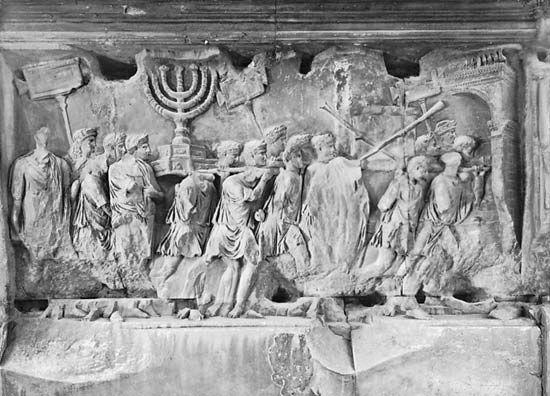The Menorah and The Vatican: Addressing Trends in Cultural Restitution

Almost 200 years since Lord Elgin shipped outcrops of the Acropolis to London, the Parthenon Marbles[1] may soon return to Greece.[2] Such a historic agreement between the Greek government and British Museum illustrates the growing public and political pressure for returning cultural artifacts to their country or people of origin. In the past four years alone, the French Parliament adopted an act authorizing repatriation of African artifacts seized during colonization,[3] Switzerland returned Mesopotamian reliefs to Iraq,[4] and the U.S. repatriated 1,400 looted artifacts to India, including items previously housed in the Metropolitan Museum of Art.[5]
In Rome, 653 miles north of the Parthenon, stands the Arch of Titus. Built nearly two millennia ago, the Arch commemorates the reign of Rome’s 1st century Emperor Titus. The ‘spoils panel’ illustrates the procession of seized treasures following his victory over the 70 CE Judean uprising. Dominating this scene is one particular treasure: the Second Temple candelabra, also known as the menorah.[6] The capture and subsequent disappearance of this symbol of Jewish antiquity has given rise to its own folklore, including a fringe but oft-shared theory that the Vatican secretly holds the menorah.[7] While antiquities scholars find the Vatican theory a pop myth with no factual basis[8], assuming arguendo the Vatican housed such an artifact, what would a restitution claim even look like? This article will examine a theoretical restitution claim, highlighting gaps in existing international cultural heritage law and proposing alternative, more equitable paths forward.
Lex Situs
Private litigation claims of cultural restitution involve suing the owning entity under local law.[9] For a suit to recover the menorah, a claim would have to be made under the Holy See law.
The first issue would be whether the Holy See’s legal system would allow repatriation. Inalienability laws created to protect against illicit trafficking have acted as a barrier for restitution on other grounds.[10] In the Vatican City State, the Code of Canon Law restricts alienation of “[r]elics of great significance and other relics honored with great reverence by the people.”[11] Additionally, Church asset management laws limit disposition of Church property above a certain monetary amount or of cultural significance.[12] Any disposition “without the approval of the competent authority” would be void.[13]
Even if the Holy See assented to alienating the menorah, European courts have denied restitution claims due to the lack of legal recognition for group ownership.[14] In 2013, France denied a claim by the Hopi tribe who sought to enjoin an auction of the spiritually significant Katsina masks under similar grounds.[15] As a religious artifact integral to Jewish cultural practices, the menorah would not have rightful group owner under Vatican City Law.
International Treaties
Public international law for interstate restitution of cultural antiquities is typically covered by bilateral treaties or multilateral treaties. The U.N. has enacted several relevant resolutions: the 1954 Hague Convention forbid wartime looting of cultural property.[16] The 1970 UNESCO Convention created a minimum level of interstate norms to combat illicit exportation of cultural goods.[17] The 1995 UNIDROIT Convention provided uniform minimal rules on “the restitution and return of cultural objects between Contracting Parties.”[18]
The issues with applying these Conventions to the menorah are three-fold. First, these treaties are non-binding and require internal ratification. The Holy See has only ratified the 1954 Hague Convention. Second, these Conventions’ applicability to Church property is questionable. Generally, these Conventions only cover improperly exported property when it is owned by the ratifying state. While the Holy See has permanent observer status with the U.N., scholars argue the Holy See does not meet statehood criteria[19], and therefore Vatican ownership would not constitute state-owned property. Finally, these Conventions are all non-retroactive, so historic takings fall outside their boundaries.[20] Unidroit acknowledges this lack of retroactivity but refuses to make licit any takings prior to ratification, allowing parties to maintain recourse through other means.[21]
A Human Rights Approach
While both the 1970 Convention and Unidroit were rooted in Western property rights, the UN’s Declaration on the Rights of Indigenous Peoples (“UNDRIP”) frames separation from cultural practices as a human rights issue.[22] Under UNDRIP, indigenous people maintain a right of restitution to spiritually or culturally significant objects taken without their consent.[23] Article 12 outlines the specific right to “use and control” lost ceremonial objects.[24] The menorah would surely fall into this category.
The major issue is defining a group for cultural ownership. UNDRIP was intentionally silent on defining indigeneity, leaving the group affiliation open to progress alongside better understandings of cultural heritage.[25] The International Law Association suggested criteria such as:
Self-Identification
Historical Continuity
Special Relationship with Ancestral Lands
Distinctiveness
Non-dominance
Perpetuation/Perseverance.[26]
Several of these apply to practicing self-identified Jews. However, by requiring a special relationship with ancestral lands, the UN enforces the notion that land is a prerequisite for access.
A more equitable approach would be modeled after the U.S.’s Native American Graves Protection and Repatriation Act (“NAGPRA”). This law repatriates artifacts and human remains to modern day tribes that can prove:
An identifiable present-day tribe or organization
The existence of an identifiable earlier group
Shared group identity between the present-day tribe and the identifiable earlier group.[27]
Applying NAGPRA’s “cultural affiliation” instead of the ILA’s indigeneity definition emphasizes that human rights should be applied to individuals and communities, not land. This is especially imperative given the UN’s acknowledgement of ongoing discrimination and human rights abuses against nomadic or formerly nomadic communities.[28]
This cultural affiliation framework would promote restitution for the menorah. Contemporaneous historians identified the Jews as a distinct group during Titus’ sacking of Jerusalem.[29] As for continuity of group identity and a modern identifiable group, Harvard University’s Pluralism Project found “Jews have been forced to flee from their homelands into galut, or exile, creating distinct and prominent communities in Babylonia, Germany, and Iberia.…These communities are still recognizable far afield and centuries after their creation, even in the United States.”[30]
Alternative Dispute Resolution
While the Holy See is not a signatory of UNDRIP, its human rights approach can be utilized in ICOM-WIPO mediation proceedings. As a member of the International Council of Museums (“ICOM”), the Vatican Museums have agreed to ICOM’s 1986 International Code of Ethics.[31] This Code, a nonbinding private transnational framework, lays out organizing principles for museums to address claims of cultural property restitution.[32] Included among these is the urging that museums should be prepared to initiate dialogue for return of cultural property based on “scientific, professional, and humanitarian principles.”[33] With the complications surrounding interstate litigation, these soft law forums are commonly used to resolve cultural restitution cases that have few other remedies.[34]
International law scholars have also advocated to expand the 1998 Washington Conference on Holocaust-Era Assets (“Washington Principles”) to restitution for colonial takings,[35] and the menorah claim could be a prima facie case for expansion to other notable historic takings.
Though non-binding, the Washington Principles have been signed by 40 states[36] and favorably referenced in European Parliament resolutions.[37] As a north star to reflect growing public sentiment the Principles have multiple benefits. First, they acknowledge the ambiguities that the passage of time has on proof of ownership, urging “fair and just” solutions even where specific owners cannot be identified.[38] Second, while also signed by state entities, the Principles are not limited to state assets.[39] Finally, the Principles acknowledge difficulties of international law in resolving these claims, and call for these considerations to be applied to the relevant alternative dispute resolutions.[40]
Conclusion
Though the menorah remains long gone, a hypothetical cultural restitution claim highlights issues in contemporary international law. The existing mechanisms created by the UN to restore historic wrongs effectuate ethno-nationalism, defining enforceable claims through either statehood or attachment to land rather than to people. By incorporating developing trends in cultural heritage law such as UNDRIP, mediators can use greater flexibility to protect cultural heritage rights for communities and ensure “just and fair” solutions.
Also known as the Elgin Marbles.↑
Sean Seddon & Kostas Koukoumakas, Parthenon Sculptures deal ‘close’, ex-Greek official says, BBC (Dec. 3, 2024) https://www.bbc.com/news/articles/cy8y97x8xm0o.
Ministère de l’Europe et des Affaires étrangères, Return of cultural goods, (Sep. 2021) https://www.diplomatie.gouv.fr/en/country-files/africa/cultural-exchanges/return-of-cultural-goods/.↑
Press Release, UNESCO, Switzerland returns a statue and two Mesopotamian reliefs of great significance to Iraq (May 28, 2024) https://www.unesco.org/en/articles/switzerland-returns-statue-and-two-mesopotamian-reliefs-great-significance-iraq?hub=416.↑
Karina Tsui, US returns looted antiquities worth $10 million to India, CNN (Nov. 15, 2024) https://www.cnn.com/2024/11/15/style/india-us-returns-antiquities-hnk-intl/index.html.↑
Ministero per i Beni Culturali e Ambientali, Soprintendenza Archeologica di Roma & the Kelsey Museum of Archaeology, University of Michigan The Arch of Titus (1997), https://exhibitions.kelsey.lsa.umich.edu/galleries/Exhibits/Empire2/monument/titus.html.↑
Sophia Hollander, Yeshiva Students Challenge Myths of the Menorah, WSJ (Aug. 14, 2014) https://www.wsj.com/articles/yeshiva-students-challenge-myths-of-the-menorah-1408069132.↑
Id. (Per one Vatican spokesperson, the menorah myth belongs to the imagined “mysteries of the Vatican” fantasies and was “never thought [to be] worthy of attention”).↑
E. Campfens, Cross-border claims to cultural objects: Property or heritage? 49 (2021).↑
The UK British Museum Act of 1963, for example, bars the British Museum from permanently disposing Parthenon Marbles to Greece. See Edward Scott, Elgin Marbles: UK government assessment of loaning the sculptures to Greece, House of Lords Library (Dec. 11, 2023) https://lordslibrary.parliament.uk/elgin-marbles-uk-government-assessment-of-loaning-the-sculptures-to-greece.↑
1983 Code C. 1190, § 2. Available at https://wipolex-resources-eu-central-1-358922420655.s3.amazonaws.com/edocs/lexdocs/laws/en/va/va001en.pdf.↑
Jose Angelo Estrella Faria, The International Protection of Religious Cultural Property, 20 Unif. L. Rev. 594, 599–600 (2015); see also 1983 Code C. 1290–1298.↑
Faria, supra note 12.↑
Campfens, supra note 9, at 49.↑
Id.↑
1954 Hague Convention for the Protection of Cultural Property in the Event of Armed Conflict, May 14, 1954, 249 U.N.T.S. 358.↑
Irini A. Stamatoudi, Cultural Property Law and Restitution: A Commentary to International Conventions and European Union Law 33 (2011).↑
UNIDROIT Convention on Stolen or Illegally Exported Cultural Objects Preamble, June 24, 1995, 2421 U.N.T.S. 457 [hereinafter UNIDROIT Convention].↑
John R. Morss, The International Legal Status of the Vatican/Holy See Complex, 26 Eur. J. Int’l L. 927 (Nov. 2015).↑
Campfens, supra note 9, at 147.↑
UNIDROIT Convention art. 10(3).↑
Lynda Knowles, International repatriation of human remains of indigenous peoples, ICOM (Aug. 8, 2018) https://icom.museum/en/news/international-repatriation-of-human-remains-of-indigenous-peoples/.↑
Resolution 61/295 (13 Sep. 2007) UN Doc A/RES/61/295: United Nations Declaration on the Rights of Indigenous People, art. 11 (hereinafter “UNDRIP”).↑
Id. art. 12.↑
Campfens, supra note 9, at 163.↑
Id.↑
Karolina Kuprecht, The Concept of “Cultural Affiliation” in NAGPRA: Its Potential and Limits in the Global Protection of Indigenous Cultural Property Rights, 19 IJCP 33, 38 (Feb. 2012).↑
United Nations, Roma, Sinti, Travellers, (last accessed Feb. 20, 2025) https://www.un.org/en/fight-racism/vulnerable-groups/roma-sinti-travellers.↑
Martin Goodman, Judaism in the Roman World 25 (2006).↑
The Pluralism Project, Diaspora Community, Harv. U. https://pluralism.org/diaspora-community.↑
International Council of Museums, Code of Ethics (2017) https://icom.museum/wp-content/uploads/2018/07/ICOM-code-En-web.pdf.↑
Campfens, supra note 9, at 157.↑
International Council of Museums, supra note 31, art. 6.2.↑
Stamatoudi, supra note 17, at 208.↑
Campfens, supra note 9, at 53.↑
Id. at 51.↑
European Parliament resolution of 17 January 2019 on cross-border restitution claims of works of art and cultural goods looted in armed conflicts and wars (2017/2023(INI)) https://www.europarl.europa.eu/doceo/document/TA-8-2019-0037_EN.html.↑
Washington Conference Principles on Nazi-Confiscated Art arts. 4, 8 (Dec. 3, 1998) Released in connection with The Washington Conference on Holocaust Era Assets, Washington, DC (hereinafter “Washington Principles). Available at https://www.state.gov/washington-conference-principles-on-nazi-confiscated-art/.↑
Campfens, supra note 9, at 53.↑
Washington Principles art. 11.↑


